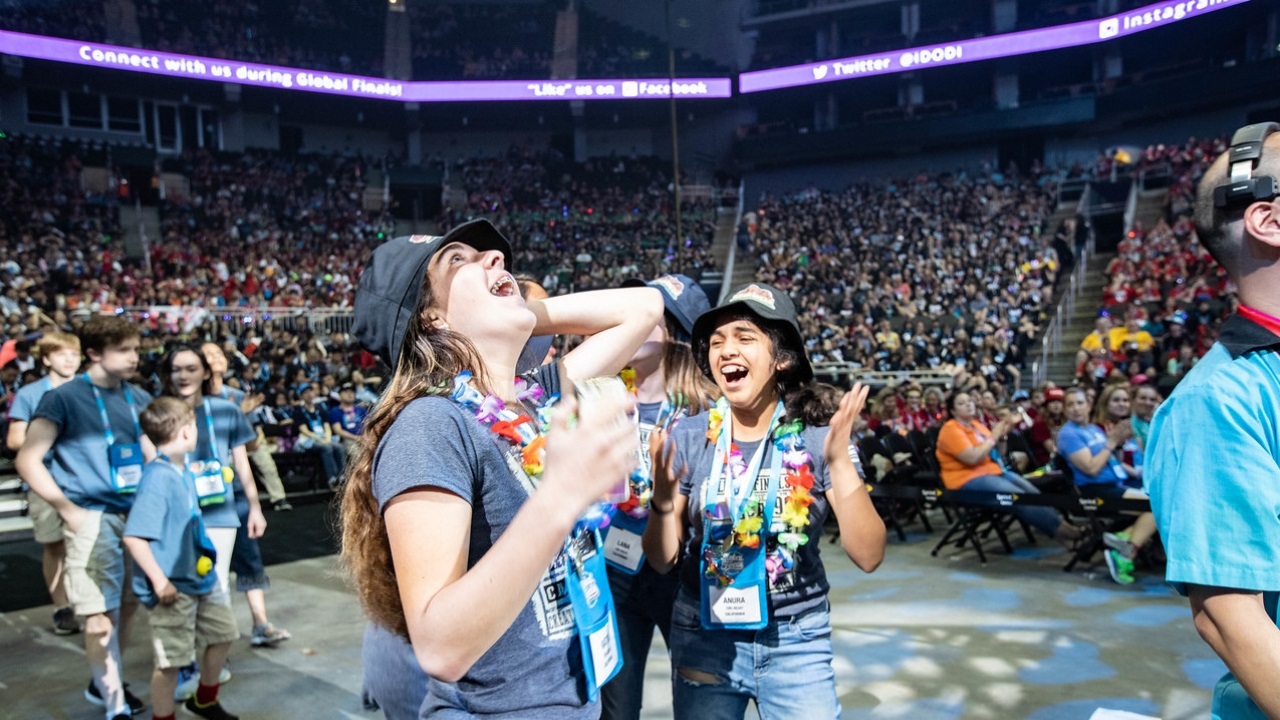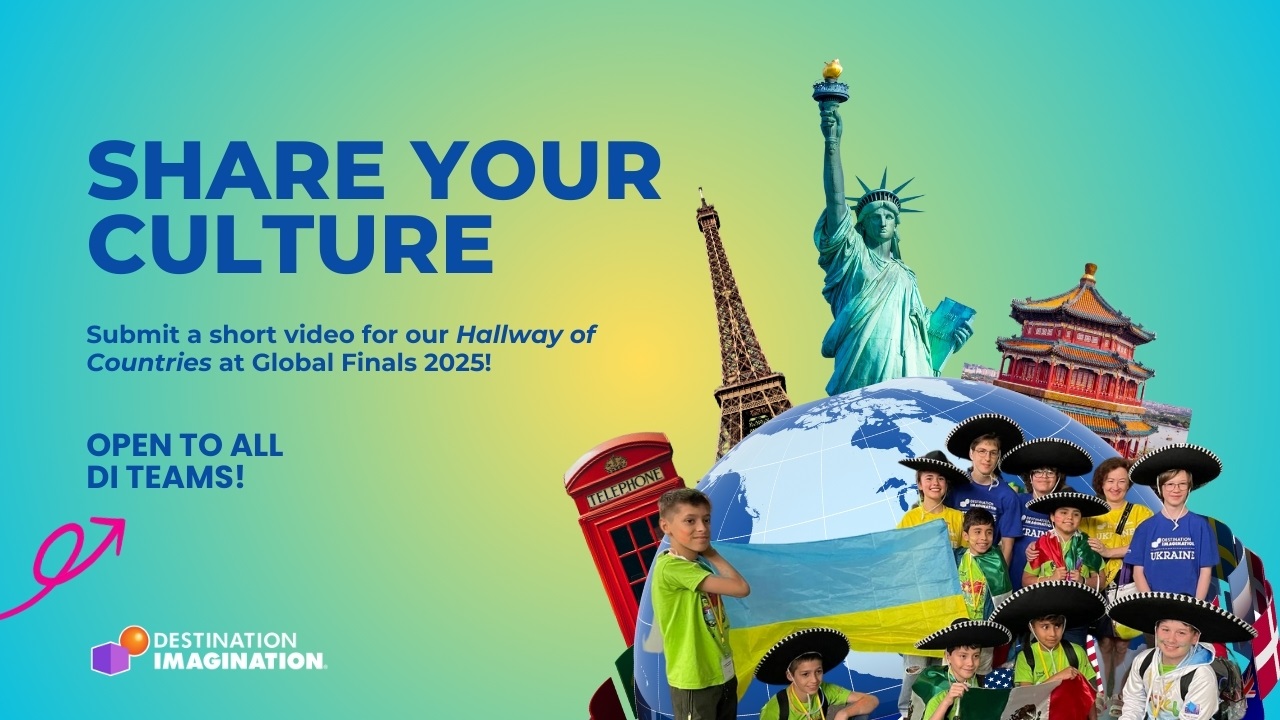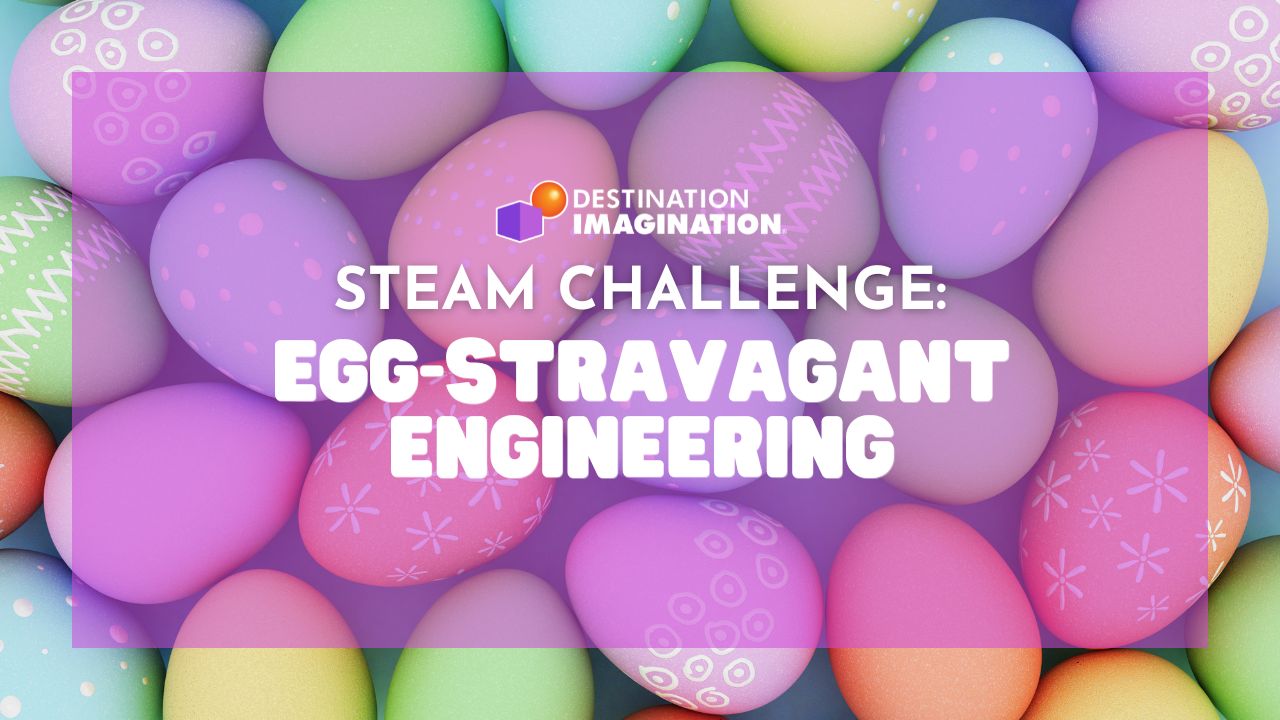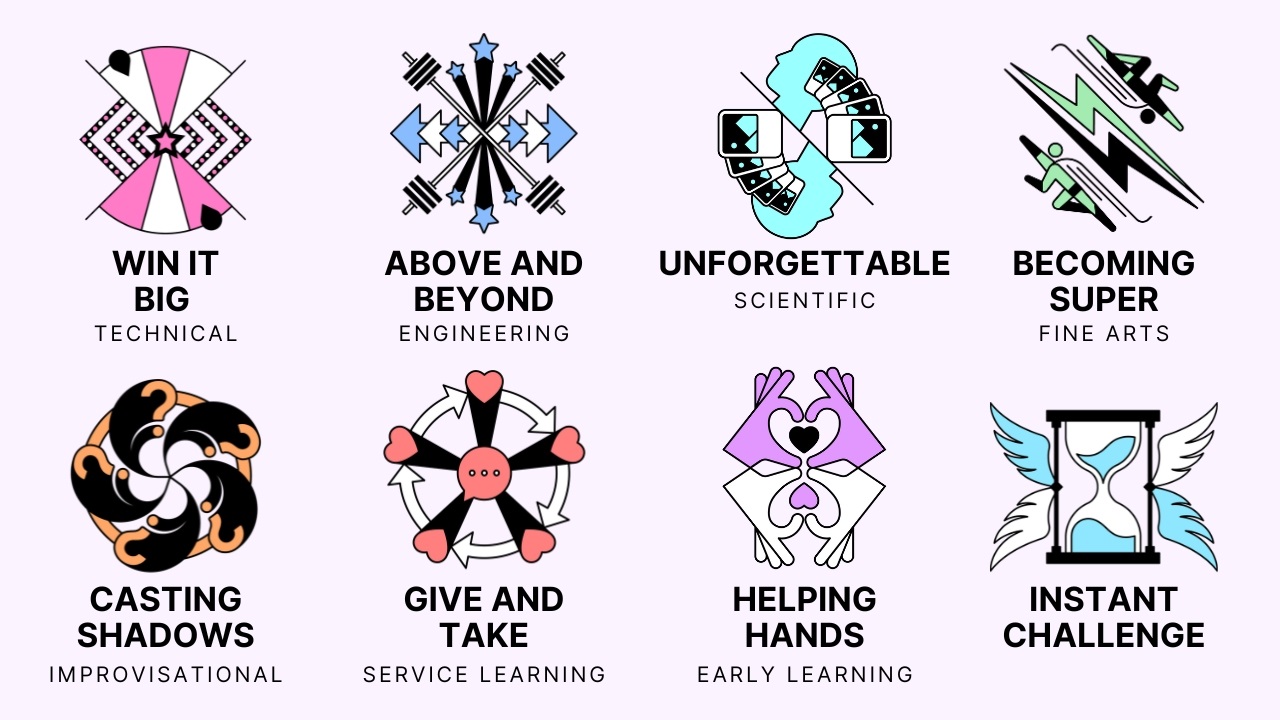In May, nearly 1,200 Destination Imagination (DI) teams from 18 countries gathered in Kansas City, Missouri to participate in Global Finals—the world’s largest celebration of creativity and the culminating event of every DI season.
Teams at Global Finals had the opportunity to showcase their solutions to one of six STEAM-based (science, technology, engineering, arts and mathematics) Challenges, which they worked on for several months prior, in their respective Challenge level (Elementary, Middle, Secondary or University Level).
Thanks to a few of our top-placing Global Finals teams and Team Managers, you can read about the Challenge solutions that helped them take top honors at the international tournament.
TECHNICAL CHALLENGE: For this season’s Technical Challenge, On Target, teams had to design and build an aircraft that could take off, fly and land. Teams had to design the aircraft to deliver a team-created payload. In addition, they had to create and present a story about one or more characters exploring a remote place, as well as create and present two Team Choice Elements that showcased the team’s interests, skills, areas of strength, and talents.
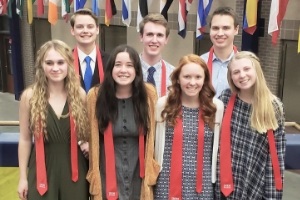 Team Name: Super Dupers
Team Name: Super Dupers
Affiliate: Indiana
Challenge & Level: Technical Challenge (On Target) – Secondary Level
Team Members: Ben M., Jenna B., Adam F., Gabby P., Sean W., Silvana G., Louise H.
Team Managers: Brian Mann, Greg Fullhart, Tracy Gold
Description: The Super Dupers want to thank the entire Destination Imagination community for giving us the opportunity to participate in such an impactful program. Our nine-year run at Global Finals has truly been an amazing experience that we will never forget. We hope to see you all again as DI alumni.
Our team’s story was set in Venice, Italy, where the canals had run dry due to the lack of rain. Leonardo Da Vinci’s daughter, Leona, needed to find a solution. She decided to use one of her father’s inventions, a helicopter, to travel into the sky. The helicopter was a full-scale model of Da Vinci’s “air screw” design. The helicopter had a seat and pedals like a bicycle that drove a rope and gear system. A computer numerical control (CNC) routing machine was used to create the gears that turned the large “air screw” made of burlap. This was one of our team’s Team Choice Elements.
As Leona ascended into the sky, she had to pass through the clouds. The team created foam clouds that were connected to a rack and pinion gear system driven by a central motor. The system caused the clouds to either move up and down or rotate mechanically. The clouds also had trap doors controlled by electromagnets that, when released, dropped blue confetti and streamers symbolizing rain. The entire system was activated via a radio frequency (RF) remote and a dual-pole duel-throw (DPDT) switch was triggered automatically to reverse the direction of the clouds, allowing the clouds to move up and down continuously. This also was one of our team’s Team Choice Elements.
Once Leona reached the sky (the remote location), she meets Mother Nature (the featured character), whose real name is Rhonda. Mother Nature lived in the sky with her husband, Father Nature, whose real name is Phil. Mother Nature is covered in leaves and greenery and is able to fly around using her mechanical wings (another Da Vinci invention). Mother Nature had a bit of a split personality. When she was talking to everyone except her husband, she sounded very sophisticated and often spoke in rhyme. When she was talking to her husband, she sounded much less sophisticated, even harsh. Mother Nature told Leona she and Father Nature could help in refilling the canals of Venice with water.
Father Nature was in charge of providing the energy to the clouds that gave rain to Venice. He did this by turning his giant fan to move an aircraft that would drop energy payloads (reinforced teabags) into the clouds. Unfortunately, Lady Music (the goddess of music) would play sweet melodies that caused Father Nature to fall asleep. Mother Nature and Leona teamed up to stop Lady Music from playing her songs so that Father Nature could stay awake and cause it to rain.
Our team’s aircraft, which was controlled by Father Nature, was a square frame made of balsa wood with a ping-pong ball at each corner and a small platform to carry the payload. The aircraft’s technical method of flight was through the use of the Bernoulli Effect. It hovered over a vehicle carrying a compressed air system consisting of four air nozzles. The vehicle was pulled down a track by a motorized cable system. Suspended in the air, the aircraft “followed” the vehicle as the vehicle moved down the track.
The vehicle and the aircraft were “blown” down the track when Father Nature turned his giant fan. The team built the fan using the same DaVinci gearing system as the helicopter in order to drive large wooden fan blades. In the fan, the team installed an Arduino microcontroller that received input from an accelerometer. When the fan was turned, the accelerometer detected motion and sent a signal via Bluetooth to another Arduino microcontroller. When this controller received the signal, it activated a motor in the cable system which pulled the vehicle down a track with the flying aircraft following it.
The payload drop was also controlled by compressed air from the same vehicle that aided the aircraft in its flight. When the vehicle passed over the drop zone, a switch on the bottom of the vehicle hit a trigger filling a small PVC tank with compressed air. A second switch then hit the trigger releasing a burst of air from the PVC tank through a nozzle. This burst would blow the payload (the teabag) off the aircraft through a tube onto the scoring area of the drop zone. Once the aircraft crossed the landing line, Father Nature would stop spinning the fan and the aircraft would land.
Ultimately, Mother Nature and Leona were able to stop Lady Music from playing so that Father Nature could stay awake long enough to turn the fan and drop the payloads of energy into the clouds. After he dropped the five payloads, the clouds released their rain filling the canals of Venice filled with water. Venice was saved.
Check out their Presentation below:
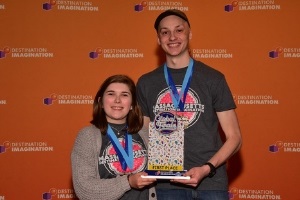 Team Name: Norwich/Endicott
Team Name: Norwich/Endicott
Affiliate: Massachusetts
Challenge & Level: Technical Challenge (On Target) – University Level
Team Members: Katie H. and Nick M.
Team Manager: Kerry Harrison
Description: Our two-person team, representing Massachusetts’ Endicott College and Vermont’s Norwich University, created a story about a bee and a chipmunk who crash land their spaceship on a faraway planet. The explorers are challenged to come up with a way to survive on a desert planet which is void of plant life and resources. During the skit, the bee and the chipmunk find a way to fabricate an aircraft from their wrecked spaceship and fly it over the planet spreading seeds that the chipmunk was hoarding in order to grow plants that will provide food and shelter.
Our team’s aircraft was a fixed-wing glider made primarily of foam board. We experimented with different types of airfoils and angles of attack to achieve the longest and straightest flight possible. The glider was designed with dihedral wings to increase roll stability and promote stable flight. Our drop mechanism was a series of rubber band cannons that ejected several interconnected stings and streamers. The payload was designed so that it could spread out and cover a large area of the target.
Some other notable elements of our solution include our spaceship backdrop with an analog lenticular animation window, which made it look like the ship was flying through space. We also utilized punch art to show flowers growing on the planet. Throughout the year, our solution constantly evolved and adapted. We had the privilege of having access to 3-D printers, machine shops, and electromechanical components ranging from Arduinos to motors, ervos, and speed controllers. These elements allowed us to experiment and refine our solution.
We want to thank everyone who supported us for this school year, especially our Team Manager and our advisors at our respective universities!
SCIENTIFIC CHALLENGE: For this season’s Scientific Challenge, Medical Mystery, teams had to research the human body and medical conditions that affect the human body. Teams then had to create and present a story about a medical mystery that affects a human character. They also had to design and build a representation that shows the medical mystery and at least one symptom, as well as present an action or scene that is shown from two or more perspectives at the same time. In addition, teams had to create and present two Team Choice Elements that showcased the team’s interests, skills, areas of strength, and talents.
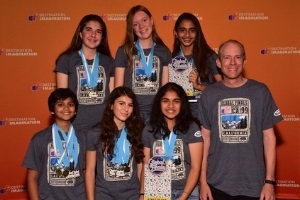 Team Name: Highly Addictive
Team Name: Highly Addictive
Affiliate: California
Challenge & Level: Scientific Challenge (Medical Mystery) and Fine Arts Challenge (Game On) – Middle Level
Team Members: Lana S., Shreya S., Jessica M., Sahil S., Anura D., Katya M.
Team Manager: Dan S.
Description: When choosing which Challenge to solve, the team was split — half wanted Medical Mystery (MM), the other half wanted Game On (GO). After reading both challenges carefully, the team decided to attempt to solve both with the same skit, characters, and props. The team chose to tackle the topic of Gambling Addiction. Solving two Challenges simultaneously was a big risk and required months of brainstorming to map a solution that hit all of the scoring categories. The required elements in MM became the Team Choice Elements (TCE) in GO, and vice versa. The summary below also details scoring elements across both Challenges (in parentheses).
Jack-lyn Pot (MM-Human) meets a casino host disguised as FUN. FUN invites Jack into her Casino (GO-Container & MM-TCE) and introduces Jack to the game of Slots (GO-Game Gizmo & MM-TCE). As Jack debates whether to gamble, her two perspectives (MM-Double Vision & GO-TCE) named Risky and Cautious weigh-in. These two perspective characters perform the entire skit in mirror-image and at multiple heights. As Jack gambles, a Dopamine character arrives on stage to describe the medical effects using a giant Face/Brain prop (MM-Symptomatic & GO-TCE).
The skit takes place across three decades that correspond to the three phases of gambling addiction (Winning, Losing, Depression/Hopelessness). Throughout the story, the inside and outside of the Casino (GO-Container) transforms 20 times as the set evolves from colorful to black & white. This transformation symbolizes Jack’s growing depression as she becomes addicted to gambling. The slot machine (GO-Game Gizmo) evolves its functions and features across 30 years, and the Face/Brain (MM-Symptomatic) shows increasing effects of addiction. To make the skit more dynamic (MM-Human), each decade also includes a choreographed song parody corresponding to the current gambling addiction phase.
Toward the end, the FUN character reveals that she has turned into ADDICTION. Jack realizes that she has a problem and changes her perspective (GO-Perspective). Gambling isn’t fun; it’s addicting.
The technical portions of the solution had a combination of elements that used Mechanical/Electrical/Structural engineering, Physics, & Computer Science.
The Slot Machine (GO-Game Gizmo) had lever operated wheels that later change to motor operated. These reels have flip-down magnets to automatically stop on a winning combination. A mechanically operated winning sound that later changes to an Arduino-programmed sound. Parallel circuit colorful lights later change to Arduino-programmed white reel-lights. Lastly, the slot appearance changes from colorful and generic, to black & white and branded.
The Face/Brain (MM-Sympt-O-Matic) conveys the three stages of gambling addiction. In the winning stage, the face smiles, eyebrows raise, dopamine squirts, and bright LEDs symbolize strong neural pathways. In the losing stage, the mouth frowns, eyebrows sink, and LEDs dim as pathways are weakened. In the depression/hopelessness stage, the eyes get bloodshot, the face gains weight and the dopamine changes color.
Solving two challenges took a significant amount of time, but the team had a ton of fun along the way. This team was also the Middle-Level winner of the DI Creative Process Video Contest. Check it out here!
Check out their Presentation below:
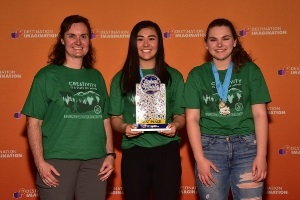 Team Name: And Then There Were Two
Team Name: And Then There Were Two
Affiliate: Washington
Challenge: Scientific Challenge (Medical Mystery) – Secondary Level
Team Members: Amy C., Anna W.
Team Manager: Eileen Chen
Description: This team’s performance depicts the symptoms and complications of pregnancy in 16th century England through the historical understanding of medicine during that time.
Disruptions of the four humors (yellow bile, black bile, blood, and phlegm) were believed to cause sickness. Bloodletting by leeches, herbal remedies, and chemical compounds were thought to restore health by bringing these four vital bodily fluids back into harmony. Illness could also be a divine punishment, and seeking medical help from the church was common.
Lady Agnes complains of severe labor pain and her well-meaning assistant provides medical advice. She learns that her contraction pain is from dyscrasia, an imbalance of all four humors, and that her “impure” baby is “devilish,” “with bloody eyes and razor teeth,” and “eating from the inside out.” Her condition is worsened by taking recommended lead and arsenic medications.
A Renaissance Award was given for the oversized representation of Lady Agnes’s pregnant womb. Retracting the Elizabethan maternity dress unveils a seven-foot baby in an amniotic sac. The amniotic sac breaks and the monster baby’s scanning blood-shot eyes, chomping fanged jaws, and agitated arms are brought to life using a cam lobe mechanism. An apothecary appears when 60 connected cascading tiles flip on a rotating door.
Lady Agnes does not survive childbirth, but the demonic newborn lives to be raised in a nunnery.
Check out their Presentation below:
FINE ARTS CHALLENGE: In this season’s Fine Arts Challenge, Game On, teams had to create and present a story that integrates research of a team-selected game, as well as create and present a game gizmo that causes an action or event to occur. They also had to design and create a container that goes through a transformation. They designed either the game gizmo or the container to be a technical element. In addition, they had to create and present two Team Choice Elements that showcased the team’s interests, skills, areas of strength, and talents.
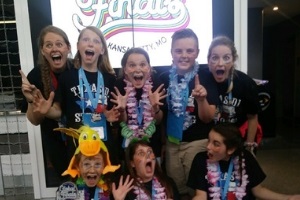 Team Name: Broadway Burritos
Team Name: Broadway Burritos
Affiliate: Texas
Challenge and Level: Fine Arts Challenge (Game On) – Elementary
Team Members: Chloe T., Jenna J., Kayte B., Grady J., Pearson U., Brady R.
Team Managers: Katie Bergvall and Casey Nelson
Description: “Wheel…of…Fortune!” The Broadway Burritos told the story of four very eccentric characters and their quest to fix the wheel and solve the puzzle in this hilarious rendition of the hit game show that has been dubbed, “America’s Favorite Game.” Their performance started with an original song that integrated facts about the history, rules and components of this popular game. The team used this time to quickly and efficiently take apart the container, which was a shipping box, to build their two settings. Their colorful adaptation of Sony Studios was complete with a letter board made from PVC, foam, and duct tape, which had a working soundboard, a contestant stand created from cardboard and over 1,220 recycled/collaged CDs, cookie boxes, drink cans, containers and more. To help enhance the two points of view, Fanny’s apartment was created off to the side with an enormous television made from wire, cardboard, cans and spoons. Fanny’s apartment let us know all about her self-proclaimed obsession with Wheel of Fortune and its hosts.
As Fanny is watching this special edition, something unexpected happens. During the live show, the contestants discover that the wheel does not have an axle and therefore is unable to spin. After an embarrassingly unsuccessful game of “Rock, Paper, Scissors,” Fanny decides that she is destined to save the day because of her expert point of view as a “Wheel Watcher.” The wheel was specially designed to spin on along the base of a device the students built using fourteen 3-D printed wheels and a hand-built dolly. Using Fanny as the axle, the game gizmo enables the contestants to finish the game, and Eugene solves the puzzle correctly, winning a lavish vacation. The story ends with another original song, which is like the epilogue, giving an update on the characters and the outcome of the episode that could have potentially been the “end” of Wheel of Fortune.
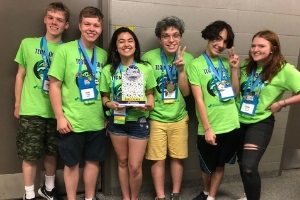 Team Name: EIEIOof
Team Name: EIEIOof
Affiliate: Oregon
Challenge & Level: Fine Arts Challenge (Game On) – Secondary Level
Team Members: Aracelli D., Eli D., Isaac D., Jonathan K., Ty P., Quinn S.
Team Managers: Jodi Dodd
This team created a technical set that used a gear-train to fold itself in half, creating a two-story set. They also made a drivable dragon, with welded, artistic, mechanical wings. Their giant hand puppet was powered by levers and extremely complex. The team-created play was about a Dragon, named Long, from Mah Jong, who felt unwanted because he was replaced by a Wild tile. So he set off on a journey to find a place to belong. On his journey to other games in the cupboard, he learned a valuable lesson. In Operation, he failed his surgery by stabbing a patient with giant tweezers. In Uno, he accidentally breathed fire breath on a card and burnt it up. Finally, in Chess, his tail accidentally knocked over the King, he realized that he really did belong in Mah Jong, where his dragon friends welcomed him.
Check out their Presentation below:
Set Design Video: Explanation of the Set
Technical Dragon Video: Explanation of the Dragon
Gigantic Hand Video: Explanation of the Hand
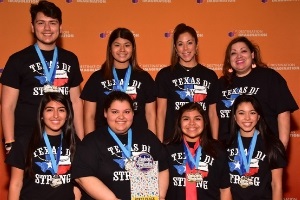 Team Name: Seguin Treasure
Team Name: Seguin Treasure
Affiliate: Texas
Challenge & Level: Fine Arts (Game One) – University Level
Team Members: Serenity D., Jaden T., Christian M., Karla V., Victoria R., and Gabby R.
Team Managers: Michelle de Leon and Jennifer Tovar. Chris de Leon (Shipping Crate Master) and Pam Krippner (District Coordinator).
Description: For our Game On Challenge, our team created the game of Karma. Our story was filled with tons of Karma research, Jumanji game elements, pawns, instructions, a decoding Gizmo and many effects bestowed with magical powers. For our Game Gizmo, Jaden put on an illusion that she was flying on a magic carpet during most of the performance. Our story was told from two points of view: an Artistic storybook that was filled with jungle artwork and a stunning depiction of the Taj Mahal, breaks the fourth wall and he narrates the story. Our second point of view comes from our Karma Kueen. She rules over the player’s existence in the game and represents the good and the bad. She keeps everyone intrigued as she magically unleashes Karma! Serenity served as our Karma character and was decorated with Henna designs, a custom-made outfit with fan designs, and a dupatta sash. Our Karma character and artistic storybook were our two Team Choice Elements.
As part of our Challenge, all of the games pieces, costumes, elements and everything else used in our solution had to be placed in a transforming container, including our Game Gizmo character. We constructed a wooden container to hold weight as well as all the props. We then added custom made cardboard towers to each side.
The story started out in a college dorm, complete with transforming lamp and computer desktop. Two girls start to play a game of Karma, when the Karma Kueen tells them the rules and instructions of the game. With the roll of the dice, our Game Gizmo tells riddles, magically decodes messages from the cards and instructs the players where to move their pawns. As the story progresses the painting reveals a jungle scene and a magical crystal ball that Karma uses to review their past to reveal their fate and existence in the game: “you get what you give.” The set then transforms as Karma and Gizmo order “huge beast on the move, this won’t be fun. Don’t try to out run them, they weigh a ton.” The set transforms into a huge elephant with a moving trunk, tusk, big eyes and the doors of the set, become flopping ears that extend with a pulley system. Throughout the game, Karma unleashes “what goes around comes around.” The “bully” grows a tail and becomes a bull, the “good” friend gets “good” karma and gets 5 free spaces and eventually wins the game of Karma with a special trip to one of the 7 wonders of the world. For the grand finale, the entire set transforms into the Taj Mahal, complete with white towers and domes on each side, free-handed calligraphy and arch on our custom container with a large onion dome (made by sewing two hoop skirts together.) The dome rises during the final song, with a Lego robotics program. In the end, Karma reminds us “Life can be a jungle, but do good deeds and allow it to make you a better person.”
We are extremely proud of this team! They are all high school seniors and they were all taking college courses and very involved in many clubs and organizations. In fact, some of our team members just earned their Associate degrees. Two of our team members, Serenity de Leon and Christian Molina, served on two advancing Global Finals teams, Seguin Treasure as well as Seguin Rocks. These students have gone through many challenges along the way, but they persevered and did an amazing job. They had a phenomenal senior year and we are so proud of them. Our 1st place World Champions!
IMPROVISATIONAL CHALLENGE: In this season’s Improvisational Challenge, Heads Up, teams had to research historical figures found on coins from around the world. At their DI tournament, they had to create and present an improvisational skit on-the-spot that included the historical figures in a tale, as well as integrate an event that has an impact on the tale. In addition, they had to present the skit in two parts, changing between comedy and tragedy, and present the skit in two styles, changing from verbal to nonverbal.
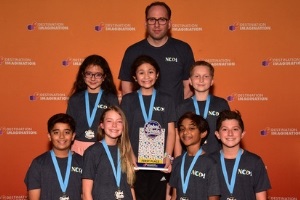 Team Name: Naturally Occurring Electrolytes
Team Name: Naturally Occurring Electrolytes
Affiliate: North Carolina
Challenge & Level: Improvisational Challenge (Heads Up) – Elementary Level
Team Members: Nadia A., Shlok K., Analia M., Kinsley P., Rohin Q., Ben V., Declan W.
Team Manager: John McD.
Description: Looking for a few good laughs? A historical comedy perhaps? I suggest watching Jane Austen and Queen Elizabeth learn how to ice skate! It is a spectacle guaranteed to make anyone crack up.
For months our team had been preparing for this moment, and now their improvisational skills were put to the ultimate test. Hours upon hours of researching figure heads and aspects of comedy and tragedy all came into play. They have “gelled” as a team, and it was evident the moment they walked out of the launch zone. During the Preparation Time, the team discussed the characteristics of the figure heads, what they knew about ice skating and how they might go about finding a way to bring everything together in the rink….all the while incorporating aspects of the comedy genre. Having practiced with countless tales, they knew how to best work together to get these two Figure Heads riffing off each other—even on ice skates!
When the Preparation Time ended, they were ready to bring this comedic event to life. It was great to watch Queen Elizabeth skate around the rink, while casually having a conversation with Jane Austen and friends. Who knew those two had such a depth of comedic knowledge? Working together, the team had the audience, Appraisers and even themselves laughing as they blended it all together in front of everyone. Then, out of nowhere, tragedy struck…THE CARNIVAL IS TAKING OVER THE BACKYARD!!!! The flip of the genre and transition from verbal to nonverbal was by far the most exciting to watch. How would they ever be able to pull it off without being able to speak a word? The only things that came to mind were trust and teamwork. Throughout their time together, the team has melded together as a band of DI-devoted, improv-loving kiddos who can tell what each other is thinking without saying a word.
The team had an absolute blast tackling this year’s Improvisational Challenge. They had fun learning about the Figure Heads, comedy and tragedy. They laughed while trying to communicate without words. But, it was most evident that this year’s Challenge required them to truly gel as a team. Once that occurred, they had the most fun, created the most memories and had the time of their lives.
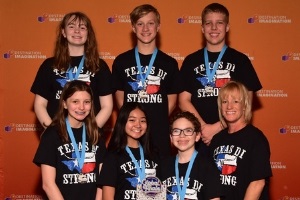 Team Name: Caarbadarbons
Team Name: Caarbadarbons
Affiliate: Texas
Challenge & Level: Improvisational (Heads Up) – Middle Level
Team Members: Olivia B., Scotty B., Jaclyn D., Olivia K., Quentin M., Reid S.
Team Managers: Abbie Sherman
Description: The Caarbadarbons have been together since the fourth grade and have made it to Global Finals every year, winning second place as fifth graders and now happy to obtain that 1st place as seventh graders! Thank you to our school district and its supporting organizations for helping to make Globals happen for us!
This year at Global Finals, the team drew Sir Seretse Khama, the first -and loved- President of Botswana, and Mahatma Gandhi. As a comedy, the team had to portray the story line – the characters are to teach the birds how to deliver mail. In the midst of the bird training an airplane with a banner approaches…and crashes, such a tragedy. The banner states the flip – the robot keeps getting in the way. Without words, the team separately portrays the flip and the storyline and then combines them to bring us to the tragic ending of the birds flying away.
Check out their Presentation below:
ENGINEERING CHALLENGE: In this season’s Engineering Challenge, Monster Effects, teams had to design and build a structure that could support weight without breaking. At their tournament, teams had to test the structure by placing weights and then removing them. Teams created and presented a story in which the sudden appearance of a monster has surprising results. They designed and created a special effect to enhance the sudden appearance of the monster and/or the events surrounding the monster in the story. In addition, teams had to create and present two Team Choice Elements that showcased the team’s interests, skills, areas of strength, and talents.
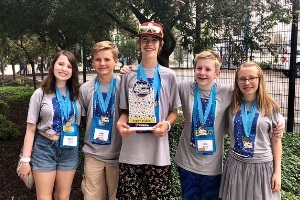 Team Name: The Zippy, Zappy, Zany, Zealous, Zoggles
Team Name: The Zippy, Zappy, Zany, Zealous, Zoggles
Affiliate: Colorado
Challenge & Level: Engineering Challenge (Monster Effects) – Middle Level
Team Members: Zach L., Luke D., Catherine M., Tate H., Molly S.
Team Managers: Michelle DuMoulin, Kern Karkos
For our sixth and final year in DI, we decided to tackle the only Challenge that we hadn’t yet completed – Engineering. We knew this was going to be a very difficult challenge, and we suspected that we didn’t have much of a chance of winning because the competition was so tough. Regardless, we wanted to be able to say that we competed in every Challenge. In fact, we received the Magellan award at our Affiliate Tournament for completing all six Challenges. Winning Global Finals turned out to be the icing on the cake.
For this Challenge, we not only had to build a balsa structure, but we also had to create a special effect that would enhance the sudden appearance of a monster. We contemplated several story ideas and special effects. We even learned how to breathe fire (though we knew that we’d never be able to use that on stage). However, our story came together when we decided to build a wooden gear grandfather clock. Our monster was an escape room that had come to life and possessed one of our team in order to trap the rest of our group. Throughout our frantic skit, the clock counted down the time left until we would be trapped forever.
Our clock was the most complicated prop we have ever built. It took months of work just to design, cut and sand all of the pieces by hand. Then we had to painstakingly assemble the pieces and fine tune it before each tournament based on the humidity at the time. It was a true test of our perseverance.
We brought to bear all of our carpentry skills and experience in order to create our props and both of our Team Choice Elements. One of our Team Choice Elements was a working wooden combination lock cut by hand and affixed to a prop door. We set the combination by cutting slots in our dials at precisely measured positions. Our second Team Choice Element was a gear mural that, once the missing gear was found and rotated, gave a clue to solving our escape from the menacing room.
Our many years of working together as a well-rounded team of engineers, artists, troubleshooters and performers paid big dividends this year with our victory in a Challenge that we knew was a long shot. Our teamwork really showed at Global Finals when several props, including one of the clock gears, broke. We didn’t assign blame. We just figured out a way to fix things with what we had on hand. Our team’s versatility also showed when our prop door broke in the freight elevator on the way to our performance. With very little time left, we were able to repair the door with duct tape in the launch area before the timekeeper called “begin.”
Very few teams ever get the chance to be on stage at Global Finals. We couldn’t have scripted a better end to our many wonderful years together as a Destination Imagination team.
SERVICE LEARNING CHALLENGE: In this season’s Service Learning Challenge, Escape Artists, teams had to identify, design, and carry out a project that addresses a need in a real community, as well as create and theatrically present a story that builds suspense about characters who attempt an escape. Teams had to integrate information about the project through clues that help the characters attempt to escape. They also had to integrate information about the future of the project. In addition, teams created and presented two Team Choice Elements that showcased the team’s interests, skills, areas of strength, and talents.
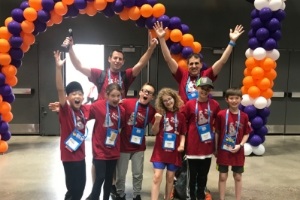 Team Name: Tragic Magic
Team Name: Tragic Magic
Affiliate: Illinois
Challenge & Level: Service Learning Challenge – Elementary Level
Team Members: Callen J., Chloe C., Evan L., Lauren J., Max R., and Will L.
Team Managers: Eric Cooper and Mike Jakymiw
Project Description: Screen addiction is a real, growing problem, and is affecting young kids. Our team researched and created a presentation for the 3rd-5th-grade classrooms at their school on the dangers of screen addiction, including the impact it may have on family and friends, as well as healthy alternatives. Following the presentation, they conducted an online survey to collect information on the amount of screen time their classmates used throughout the week, as well as some of their emotional reactions. Having collected prizes from local businesses, they hosted a “Screen-Free Week” raffle, where students earned a raffle ticket for every day that they had no screen time (other than for school work of course!). They estimated that they reduced over 1,000 hours of screen time within their school that week.
Project Solution: While playing a video game with his best friend Claire and after getting upset at a lost level, Joe was sucked into “The World of Magic.” In order to escape, Joe had to help a boy in the game, Aaron, overcome an upcoming obstacle. He thought it was the magic competition that Aaron was competing in, but when Aaron lost in the competition, Joe realized that Aaron had “magic” addiction. Having lost a few hearts for bad decisions along the way, and with time running out, Joe still was stuck in the game. It was only after recognizing that he had screen addiction that he was able to escape the video game.
As the Appraisers summarized in the Renaissance Award, “Time was short, and they didn’t waste a second telling a compelling story replete with hydraulics, chemistry, optics, pulleys, elevators and combination locks, wrapped up in a Swiss Army box.” The team’s three clues were: (1) an original song with choreography and “emotion” boxes that communicated the effects of screen addiction, (2) a hydraulic, articulating claw that stole the boy’s magic wand to reduce his reliance on magic, and (3) an infographic based on the classroom survey that lit up as Claire highlighted numbers that helped unlock a working lockbox. As one the team’s TCEs, Claire “played” the video game and controlled Joe’s actions while in the game, using a detailed and perfectly timed claymation, stop-motion animation that displayed all of the action being acted out on stage. As Claire made decisions in the game, it affected what Joe and Aaron did during their journey to escape their addictions. Ultimately, Joe was able to return to the real world and pledged to reduce his screen TIME.
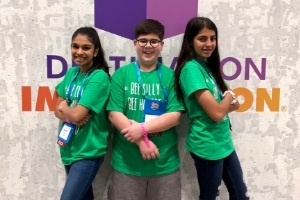 Team Name: S.A.M’s Busy Bees
Team Name: S.A.M’s Busy Bees
Affiliate: Texas
Challenge & Level: Service Learning Challenge (Escape Artists) – Middle Level
Team Members: Saraya P; Abigail D; Max H
Team Manager: Sunita Patel
Description: For the team’s Service Learning project, they raised awareness about the ill effects of dementia and the need for soothing and calming busy blankets to ease the suffering due to loss of memories. The team handmade and personally donated 42 denim lap blankets made out of recycled jeans. Each blanket included buttons, pockets, beads, ribbon, clasps, zippers and more for patients at two memory care facilities in their home town of Frisco, Texas.
From beginning to end of the team’s performance, the team created an immersive insect garden environment where insects, specifically a ladybug and a butterfly, are “trapped” (so they think) in a memory care facility and want to “escape” their minds and get their memories back. Thankfully, a “busy bee” is there to help them ease their fears by providing them with busy blankets and the info they need to get through the day.
The butterfly and ladybug (representing adults with dementia) want to escape their situation and find their way back to “memory lane” because they think that’s where all their memories are. As ladybug and butterfly try to escape, good and evil are at play, seen by a single team member portraying 2 characters. The “good” was represented by a busy bee, the caretaker of the memory care insect garden, that helps the insects live comfortably and in the future make Busy blankets to help soothe and ease their anxiety. And then there was the evil Ant, “Al Z. Heimer” that was lurking to steal all memories from the elderly insects throughout the entire performer. The good and evil were represented by one team member wearing a reversible costume that physically switched between both characters effortlessly as the story progressed. The costume was made out of hundreds of braided straws, spoons, braided trash bags with a double-sided headpiece that also reversed on the team member with one quick movement.
Throughout the performance, the ladybug and butterfly almost exclusively are “on” their set, barely touching their feet on the ground. The set included a walkable bridge, an under bridge area with a drop-down spider web, a log that was used horizontally for hiding, vertically for climbing and hiding and back again horizontally to walk on and attempt to escape on. Lastly, the team also created a four-sided bi-level platform that changed scenes from a grassy lookout to a drop-down showcase of their Service Learning project to an actual slide designed to look like a waterfall and then to an insect house that was ultimately empty with no memories. For a team of just three team members, they carefully and innovatively set out to fill their performance space and show insects crawling, climbing, flipping, sliding, peeking and walking.
The Challenge required three clues to be used that in their escape : 1.) artwork appearing to be a pair of blue denim jeans constructed out of twisted plastic knives to represent the jeans used to make the busy blankets, 2.) a green vine made from insulation pipe foam that was braided during the performance to info about their community partners which also had a secret direction hidden in it as well guiding them to the next clue, and 3.) “rocks” were blocking the insects way so they threw them to get rid of the “negativity” and put them on a technically made pulley and hoist built double sided contraption that when weighed down, a firefly rose up in the air to light up a number representing the actual number of blankets that were made during the project. Butterfly and ladybug then think that same number is a house number on memory lane. Sadly, in the end, the house they found was empty and unfamiliar. As is the case with dementia, the mind deteriorates and memories are lost. The characters did not escape nor did they remember any of the events the next day. Busy Bee was there to help care for them again and the evil Ant will always be lurking to steal memories over time.
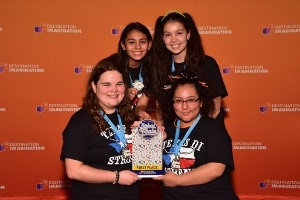 Team Name: Timeless Turtlenecks
Team Name: Timeless Turtlenecks
Affiliate: Texas
Challenge & Level: Service Learning Challenge (Escape Artists) – University Level
Team Members: Berkley S., Joel R., Isabella I., Lexi F.
Team Manager: Lori Butler
Description: This year was exceptional for this team as all except for one student were newcomers to DI as high school seniors in Dual Credit. After the Challenge was presented to them, the team spent a lot of time deliberating about community needs in the area. The team felt that there was a lack of a sense of pride in the community, especially among the schools because of some changes in administration. With this in mind, the team of seniors set out to find a solution that would not only benefit the community, but that would be something that could outlast their enrollment. The team decided that in order to create a better environment of pride among their school district and local community, they needed to start with young students and show them the importance of preserving history and how fun the help/mentorship of students could be. This caused the creation of Time Capsule Day, a day where the team collected autobiographical coloring sheets from their local pre-school to store away for the student’s graduation. Young students had to draw and color in boxes with prompts like, “What do you want to be when you grow up,” and they traced their hand on the back. They thought that preserving their history would be fun for them so that they’re excited to graduate and see what they were like as kids.
Little did the two mad scientists know that the different creations of the students on Time Capsule Day would end up being the solutions to move on and save the universe. A giant meteorite was headed to Earth and it was up to these scientists to find a way to save mankind. Mankind was quickly running out of hope as they tried to comfort each other by creating time capsules and cheering on the scientists, but the scientists had a shot at changing their fate. The two scientists, Dr. Veronica and her calculus and Pokémon obsessed intern, created a multi-dimensional machine, the T.I.M.E., that could take them to different dimensions to try and find a new place to move the population of Earth. Upon their arrival to the three different dimensions, the ominous Guardian of the Multiverse tasked them with challenges from different residents from each place that tested whether they were worthy of multidimensional travel. Among these, they had to solve puzzles and finish timed math problems given to them by Backwards Girl and The Toxic Dragon to prove mankind was worthy. Once they found their desired location, the Guardian gave them an empty time capsule that they had to fill with what they believed were the most important creations of mankind. The correct combination of elements were coloring sheets and pictures of the students at Time Capsule Day. With this, they ended up saving the people of Earth.
The T.I.M.E. was constructed of an old computer server shell, which stood about 6 and a half feet tall. It was metal and attached to it were old computer parts and electronics from the community and garage sales. The giant machine was covered with materials from keyboards and wires to cassettes and old Atari games, making it 100% recycled material. Along with this, the team used creative materials to construct a dragon costume made from caution tape, trash bags, cardboard, and of course, a good deal of hot glue. The team got the idea for their name because the scientists in the skit wore lab coats and doc martens with their black turtlenecks.
After finishing their Instant Challenge, the team rushed back to Greenville, Texas and made it back home just a few hours before their graduation ceremony started. They finished with three first place wins for the year.
To see additional Global Finals Presentations from 2019 and previous years, check out our YouTube playlist.
